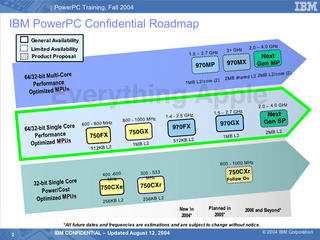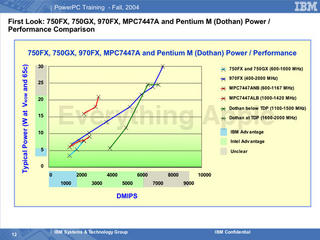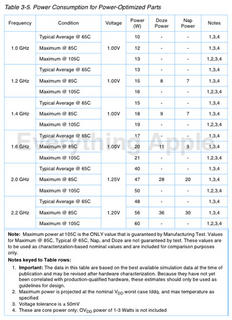After 40 weeks since the last iBook release, Apple finally updated its iBook line. The release is pretty much in line with previous predictions:
12" screen
1.33 GHz G4 7447A
40 GB HD
512 MB RAM
Core Image GPU (Radeon 9550, better than the predicted GeForce FX 5200U)
We also see built-in Airport Extreme (as before), included Bluetooth 2.0, Sudden Motion Sensor technology to protect the hard drive, and the scrolling trackpad. What we don't see is 64 MB RAM for the GPU. Given the relatively low resolution of the screen, 32 MB is usable, even though 64 MB would have been preferred. We didn't see a widescreen form factor, but that seemed unlikely in the first place. The price is unchanged, at US$999.
The 14" iBook now has a built-in SuperDrive as well, whereas it used to cost $1499 with the SuperDrive. If you don't need the SuperDrive, you can select a combo drive to bring down the current 14" model's price to $1199. Interestingly, the 14" iBook has a 142 MHz bus, which doesn't exist on any other Mac as far as I know.
Overall, the new iBooks look like a very nice buy. I bought the new iBook 12" in fact.
However, the Mac mini updates, although reasonable, are more of a mixed bag. They didn't get a clockspeed upgrade, and they did not get a fully Core Image compliant GPU. In the era of Tiger, I would have hoped that all Macs would support the full Core Image feature set in hardware. More important however is the fact that the Mac mini did not receive an increase to the amount of GPU RAM included. While 32 MB is passable on the iBook (with its built-in 1024x768 screen), it is too little for a 2005 desktop in my opinion. Running Exposé with 32 MB on a 17" screen is not ideal (although acceptable for many), and can be outright painful on a 20" screen.
The 1.42 GHz Mac mini seems like a more reasonable upgrade. Apple has stopped including the modem on those units, but instead have included internal Airport Extreme and Bluetooth, a nice upgrade. Thus, it seems the new bang-for-the-buck Mac mini unit is the $599 1.42 GHz Mac mini. It's still stuck with the 32 MB GPU RAM though.
One wonders if part of the reason the Mac mini did not get a speedbump relates to the power output and cost of the CPU. Freescale's datasheet claims the 1.42 GHz G4 7447A has a maximum power output of 30 Watts. Keeping the CPU at 1.42 GHz keeps costs down, and makes it easier to keep Mac minis from overheating. Mind you, the 12" PowerBook handles the 1.5 GHz G4 just fine, and the 15" PowerBook goes up to a 1.67 GHz G4.
Because the Mac mini's upgrades are not as impressive as they could have been, those looking at the Mac mini really should look hard at the iMac G5 too. It is a very good value, and in my opinion represents the better buy for most customers.
[Update 2005-05-27]
Sergey asked if I'm sure the Radeon 9550 supports Core Image. The answer is yes, I'm sure it has full hardware Core Image support. It seems that Apple's Core Image page just hasn't been updated yet.
By the way, my iBook shipped today. :)
[Update 2005-05-27 Part 2]
Apple's Core Image page has now been updated to include the Radeon 9550.
Tuesday, July 26, 2005
Sunday, July 24, 2005
Confidential IBM roadmap: 970GX coming, 970MX proposed
IBM has published a previously confidential PowerPC roadmap from last year which covers things from 970FX power specs to future chips such as the long rumoured 970GX. There is also mention of a proposed 970MX, which appears to be a dual-core chip with speeds over 3 GHz and 2 MB shared L2. (This should not be confused with the 970MP, which has 1 MB L2 dedicated to each core.)

Despite the claim that the 970GX will have general availability in 2005, we have not yet had previous official confirmation of this chip. However, there has been an unofficial mention of the 970GX. Also, it remains to be seen whether or not the 970MX will ever see the light of day. In the meantime, we are still waiting the appearance of 970MP Macs, which I believe will become available within six months.

In terms of power specs, IBM claims that the G5 970FX is superior to Freescale's current G4 7447A at most clock speeds, measured by performance per Watt. What is interesting though is that even IBM concedes that Intel's Pentium M Dothan is superior with this measure at moderate speeds and possibly also at higher speeds. However, these power specs do not seem to include numbers for IBM's new low power G5 970FX. For example, the new 1.6 GHz low power G5 is listed at 21 Watts max, but the roadmap lists it at 31 Watts max, nearly 50% higher. Still, it is likely that Dothan still wins in terms of performance per Watt overall.

Despite the claim that the 970GX will have general availability in 2005, we have not yet had previous official confirmation of this chip. However, there has been an unofficial mention of the 970GX. Also, it remains to be seen whether or not the 970MX will ever see the light of day. In the meantime, we are still waiting the appearance of 970MP Macs, which I believe will become available within six months.

In terms of power specs, IBM claims that the G5 970FX is superior to Freescale's current G4 7447A at most clock speeds, measured by performance per Watt. What is interesting though is that even IBM concedes that Intel's Pentium M Dothan is superior with this measure at moderate speeds and possibly also at higher speeds. However, these power specs do not seem to include numbers for IBM's new low power G5 970FX. For example, the new 1.6 GHz low power G5 is listed at 21 Watts max, but the roadmap lists it at 31 Watts max, nearly 50% higher. Still, it is likely that Dothan still wins in terms of performance per Watt overall.
Thursday, July 21, 2005
IBM publishes low power 970FX power specifications

IBM has released several new documents about the PowerPC 970FX and its low power variant. One of the new documents is a new 970FX datasheet which includes typical and maximum power specifications of the new low power G5 970FX.
The low power 970FX can operate with a voltage as low as 1.0 V. At 1.6 GHz, the typical power usage is 17 Watts, with a maximum power usage of a mere 21 Watts. If this maximum power usage value is accurate, then that is probably about a one-quarter power savings over previous parts, and somewhat better than I had previously thought. Although no specifications are given for a low power 1.8 GHz G5 970FX, one might expect that say a 1.1 V part would come in at close to or perhaps less than my previously predicted 30ish Watts. Such a chip would make for a reasonable laptop CPU. However, as previously stated, Apple may choose to use the G4 7448 instead (also at 1.8 GHz) for the next iteration of the PowerBook, before the switch to Intel.
IBM has not yet published power specifications for their dual-core 970MP. If the single-core 970FX 2.2 GHz puts out 60 Watts max (according to the datasheet), then it seems a dual-core 2.5 GHz 970MP might be quite a hot chip. On the other hand, Apple claims the 2.3 GHz 970FX is only 55 Watts, and has done so for the past six months, so it is possible the dual-core 970MP 2.5 doesn't have to be overly hot. We won't know for sure, however, until IBM publishes its specs.
New iBooks and Mac minis soon
The iBook recently went to 5-7 day shipping for stock units at the Canada Apple Store and 7-10 days shipping for CTO units at both the Canada and US Apple Stores. The Mac mini also just went to 5-7 days shipping.
I'd expect new updates within the next couple of weeks, and perhaps as early as Tuesday.
For both the new Mac mini and new iBook, I hope to see a Core Image-compliant GPU (eg. GeForce FX 5200, possibly with 64 MB RAM) and an increase in the stock memory to 512 MB. I would also expect to see new G4 updates, utilizing faster clocked MPC7447A chips. Otherwise I don't expect major changes, besides maybe an increase in the hard drive size, especially for the low end iBook (which is currently at 30 GB). The widescreen iBook that some have predicted seems very unlikely for this update.
[Update 2005-07-22]
Think Secret states that new iBooks and Mac minis are due next week, and will include a US$699 model for the Mac mini.
I'd expect new updates within the next couple of weeks, and perhaps as early as Tuesday.
For both the new Mac mini and new iBook, I hope to see a Core Image-compliant GPU (eg. GeForce FX 5200, possibly with 64 MB RAM) and an increase in the stock memory to 512 MB. I would also expect to see new G4 updates, utilizing faster clocked MPC7447A chips. Otherwise I don't expect major changes, besides maybe an increase in the hard drive size, especially for the low end iBook (which is currently at 30 GB). The widescreen iBook that some have predicted seems very unlikely for this update.
[Update 2005-07-22]
Think Secret states that new iBooks and Mac minis are due next week, and will include a US$699 model for the Mac mini.
Thursday, July 07, 2005
IBM announces dual-core G5 970MP and low power G5 970FX

IBM today finally officially announced the long-rumoured dual-core G5 970MP at the 2005 Power Everywhere Forum. (Japanese press release) The chip is expected to hit 2.5 GHz and will sport a total of 2 MB L2 cache, as we had predicted. I would expect to see a quad G5 Power Mac based on this chip relatively soon (within the next 6 months).
IBM also announced a low power version of the G5 970FX, with a rated power utilization of 16 Watts at 1.6 GHz. This specification is IBM's "typical" power, which is significantly lower than its maximum power. A reasonable estimate might be that a 1.8 GHz G5 970FX could be produced with a maximum power utilization not too much higher than 30 Watts (which is appropriate for a laptop). A laptop G5 at 1.8 GHz would be in agreement with earlier predictions.
While a Power Mac based on the dual-core 970MP seems obvious, it's not so clear for a new PowerBook based on the low-power 970FX. A G5-based PowerBook would require an entirely new design, and such a machine is unlikely to be released if the switch to Intel in PowerBooks came early next year. It is possible that Apple may choose to release a speed-bumped PowerBook using the current design and the new G4 7448, which is a direct replacement for the 7447A used in current PowerBooks. In 2006 Apple could release an x86 PowerBook based on the new dual-core Pentium M Yonah to replace the G4-based PowerBooks, skipping the G5 entirely.
Thanks to M. Isobe and Xlr8yourmac.com, who first broke the 970MP and low power 970FX news.
[Update 2005-07-07]
The English press release is now available:
Momentum for Power Architecture Technology Accelerates in Japan
IBM today announced the newest member of the Power Architecture family of microprocessors -- the PowerPC 970MP. The new processor is a dual-core version of IBM's award winning PowerPC 970FX, targeted for clients who desire a low-cost, high performance, 64-bit, symmetric multiprocessing (SMP)-capable system in a small package with ranges from 1.4 to 2.5 GHz. The microprocessor also provides power-saving features that system architects can use to dynamically control the system power.
The IBM PowerPC 970MP microprocessor builds on the proven 64-bit IBM Power Architecture family and is designed for entry level servers as well as to provide new levels of performance and power management for the embedded marketplace. The increased computing density of the PowerPC 970MP brings a new level of performance to a variety of applications, from HPC clusters to demanding embedded system applications such as high performance storage, single board computer and high performance networking applications.
Each of the two 64-bit PowerPC 970MP cores has its own dedicated 1MB L2 cache, resulting in performance more than double that of the PowerPC 970FX. This design provides clients with a wide range of performance and power operating points that can be selected dynamically to match system processing needs. The frequency and voltage of both cores can be scaled downward to reduce the power during periods of reduced workload. For further power savings, each core can be independently placed in a power-saving state called doze, while the other core continues operation. Finally, one of the cores can be completely de-powered during periods of less stringent performance requirements.
IBM also announced today new low-power extensions to its award-winning PowerPC 970FX offering. This newest offering is targeted for clients who desire a low-cost 64-bit processor featuring high performance, a sub-20 Watt power envelope and SMP. The new offering is targeted to provide an operating power of 13W at 1.4 GHz and 16W at 1.6GHz under typical workloads. The microprocessor also provides power-saving features that system architects can use to dynamically control the system power.
The 64-bitPowerPC 970FX microprocessor builds on the proven 64-bit IBM Power Architecture family and is suited to embedded applications including imaging and networking, and provides new levels of performance and power management for the embedded marketplace. Designed to run at frequencies up to 2.7 GHz, the PowerPC 970FX includes a 512KB L2 cache, provides native 64-bit and 32-bit application compatibility and uses a high bandwidth processor bus capable of delivering up to 7.1 GB/s to keep the processor core and the SIMD/Vector engine fed with data. The processor core can dispatch five instructions per cycle, and issue one instruction per cycle to each of its ten execution units, including two fixed point, two floating point, two load store, two vector and two system units. The L1 instruction cache holds 64 KB, the L1 data cache holds 32 KB, and each processor has its own dedicated 1MB L2 cache.
Sunday, July 03, 2005
The real iTunes phone unveiled
Sane minds have prevailed. Pictures at Engadget show that (at least one version of) the Motorola iTunes phone is indeed a white E790 and not the aesthetically-challenged Xbox phone.
More pictures of the phone are posted at the Hebrew language forum, Pocket.co.il.
[Update 2005-07-04]
Apparently, Pocket.co.il claims the phone will be called the "E1", but details are otherwise scarce.
More pictures of the phone are posted at the Hebrew language forum, Pocket.co.il.
[Update 2005-07-04]
Apparently, Pocket.co.il claims the phone will be called the "E1", but details are otherwise scarce.
Subscribe to:
Posts (Atom)